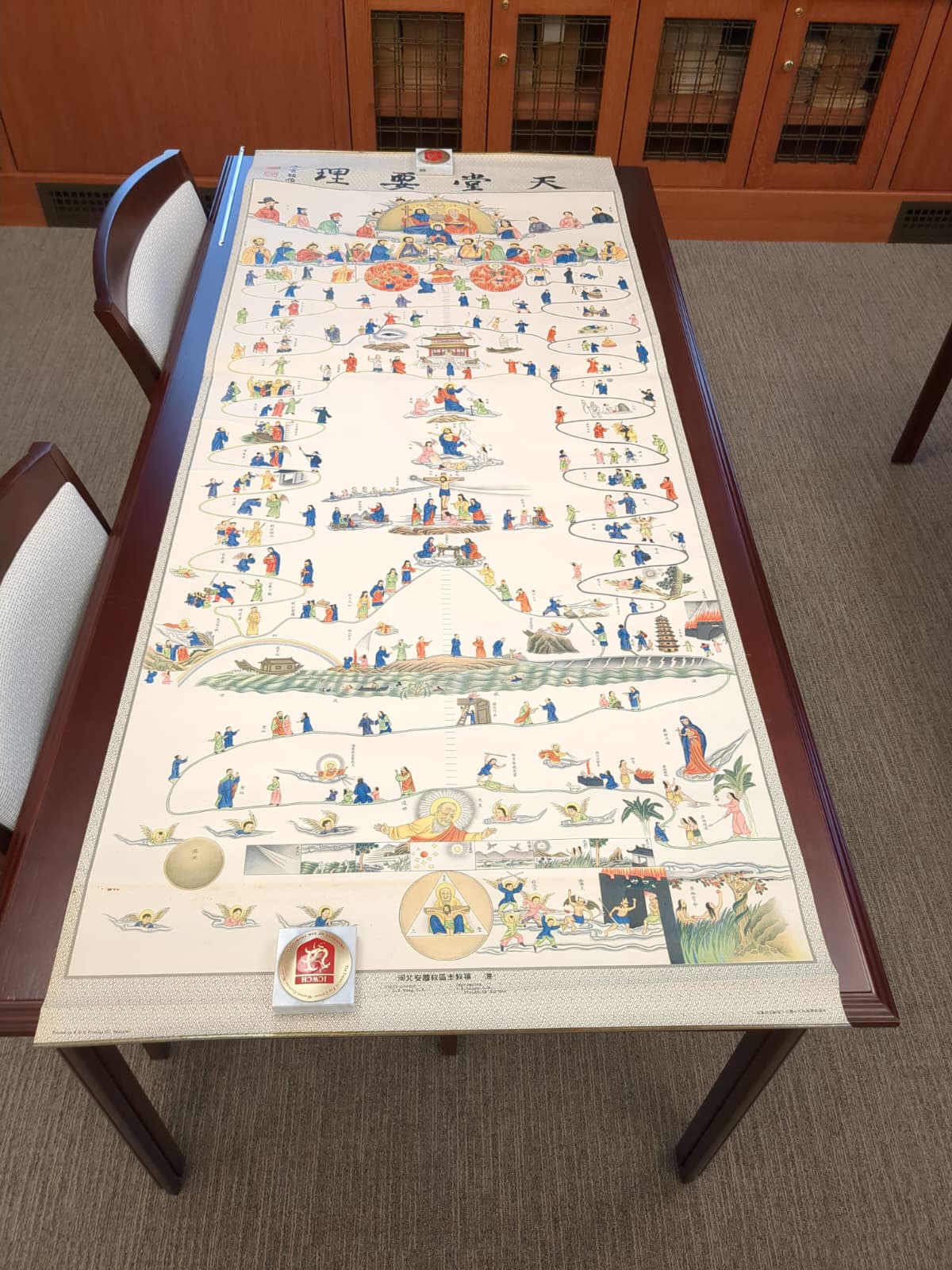| Date | 1937 |
| Publish_location | Shanghai 上海 |
| Publisher | K & K Printing Co. 三一印刷公司 |
| Collection | Ricci Institute Library [JPW] |
| Language | Chinese 中文[繁體] |
| Record_type | Scroll |
| Shelf | Scrolls |
| Call Number | N7983.L58 1937 |
| Description | Hanging scroll |
| Note | Tiantang yaoli 天堂要理 / Ma Xiangbo 馬相伯, 1840-1939; Melchior Souen 孫德楨, 1869-1951; Jean-Baptiste Wang 王增義, fl. 1884-1933; Raymond de Jaegher 雷震遠, 1905-1980; Liu Yuejue 劉樂爵 de Sales.
The title is given in the (printed) calligraphy of Christian scholar and educator, Ma Xiangbo 馬相伯 (1840-1939). We believe that the calligraphy is signed "Xiangbo, the old man of 97 [sui]" 九七雯 (=叟) 相伯,from which we are inclined to conjecture that he wrote the calligraphy in 1936 (1937 if he was using Western reckoning). There are two printed seals, one reading "Xiangbo" 相伯 and the other—we think—"Ma Liang" 馬良, Ma's given name (ming 名). The bottom of the scroll carries the inscription "With the approval of Bishop Sun of Anguo [Ankwo] diocese, Hebei" 河北安國教區主教孫准 in Chinese and "nihil obstat | J.B. Wang C.M." and "Imprimatur |+ M.Souen C.M. | Vic.Ap. de An-Kwo" in Latin, indicating the approval of Melchior Souen (Sun Dezhen 孫德楨), C.M. (1869-1951), Vicar Apostolic of Anguo in 1929-February 7, 1936, and Jean-Baptiste Wang (Wang Zengyi 王增義), C.M. (fl. 1884- On the verso of the scroll, toward the bottom, it is written "Catechisme de Jaegher" in red ink. Jeroom Heyndrickx ("Catechesis on Heaven 天堂要理:A Chinese Catechetical Painting Prepared by Raymond de Jaegher SAM and Br. Liu Yuejue CSJB Introducing the Christian Message to Chinese Farmers," in History of Catechesis in China, 255-65, eds. Staf Vloeberghs et al. [Leuven: Ferdinand Verbiest Institute, 2008]) describes the genesis of the poster, which originated as a painting used in the Hebei countryside in 1934-1935. Fr. Raymond de Jaegher, SAM (Lei Zhenyuan 雷震遠, 1905-1980) and Br. Liu Yuejue 劉樂爵 de Sales (n.d.) asked several local artists to paint the scroll, which was modeled on a catechetical picture printed in France for use among the first nations people of Canada. A possible candidate for what this picture might have been is Albert Lacombe's, O.M.I. (1827-1916) Tableau-catéchisme from 1873, which in turn was based on images made for use among the native people's of what is now the US Pacific Northwest. Whatever the case, the picture that Liu saw presented a "good path" and an "evil path," a format that Liu and de Jaegher adopted. Eventually, de Jaegher approached Lucas Chen, who did not end up taking the job, and subsequently Chen's younger brother, Chen Zhao 陳照 (n.d.), who agreed. Liu and de Jaegher were not satisfied, and in the end a non-Christian artist by the name of Fu Zhongwu did the job. Fu's painting was sent to Shanghai, where Liu negotiated its printing in September 1935. The fact that the painting was handed off for printing already in 1935 would explain why it still lists Souen as Vicar Apostolic even though it was printed in 1937. K & K Printing Co.'s original printing facilities were destroyed during the Japanese attack on Shanghai, which began in August 1937, so we assume the poster was printed in the first half of the year. Heyndrickx's article does not make clear exactly how the painting that he describes relates to the one that was sent to Shanghai for printing. It is clear, however, that it differs from the print in both content and style. To our eyes, the poster looks closer to the style of the Fu Jen school than Donation by Jean-Paul Wiest. With thanks to Zhang Jie (Arizona State University). Note: This catalog entry has been repeatedly revised as we have learned more about the scroll |
| Subject | Scrolls, Chinese--Christian themes Vincentians--Missions--China--20th century Catechisms, Chinese--19th-20th centuries Hebei Sheng 河北省--Religious life and customs |
| Multimedia |  |